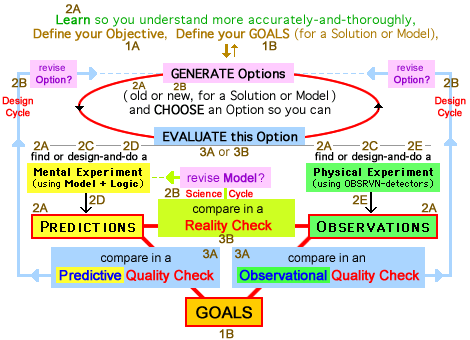|
What kind of Knowledge-and-Skills Curriculum
will produce optimal Whole-Person Education?
multiple goals and limited resources: Above I describe a common strategy for Goal-Directed Designing of Curriculum & Instruction, as in designing a Coordinated Wide-Spiral Curriculum using Instruction with Activities that are Fun and Personally Useful. When educators are doing their goal-directed designing, they want their overall Whole-Person Education to achieve multiple goals – by helping students improve in a variety of ways, in many areas of life – but they have limited educational resources (of time, people, money,...) so they must make tough choices about goals by asking “what resources should be invested in each kind of goal?”
knowledge and skills: It can be useful to view education as a Knowledge-and-Skills Curriculum with the goal of helping students improve their knowledge and their skills that include skills-with-knowledge.
mutual support: The beginning of my verbal-and-visual model for Design Process (i.e. for Problem-Solving Process) is to "Learn so you understand more accurately-and-thoroughly" because productive problem solving occurs when we effectively combine creative-and-critical thinking with relevant knowledge in the problem-solving area. Thus, one benefit of better subject-area knowledge is better problem-solving skills. We also see the reverse, with research showing that using metacognitive problem-solving skills – in metacognitive Self-Regulated Learning – does solve problems (i.e. it does make things better) by improving students' learning of knowledge and skills.
supplementing, not replacing: Due to this mutual support, our instruction for skills-with-knowledge (including higher-level thinking skills) should supplement – not replace – basic skills (for reading, math, science,...)* and knowledge (in sciences, social studies, history, literature,...). { * but “basic skills” can involve “higher-level skills” }
trying to optimize: Educators generally agree that we should try to help students improve their skills (basic & higher-level) and knowledge; and that we should aim for an optimal combination of knowledge and skills & skills-with-knowledge. But when we ask “what is optimal?” there are disagreements. Some educators, including me, think the balance should shift toward more emphasis on skills and skills-with-knowledge, by using a Curriculum for Problem Solving that improves the problem-solving skills of students and also their motivations to “make things better” – for themselves & for others – with problem solving. { It can be useful to view this kind of curriculum as Whole-Person Education for Problem Solving; or as Education for Whole-Person Problem Solving with the objective of Making Things Better for Whole Persons. }
But doing this effectively will depend on actualizing two IF-factors: Instruction with stronger emphasis on problem-solving skills will produce large-scale improvements only IF the instruction is educationally effective and IF it is widely adopted by teachers and their schools & districts. When making a decision (Yes or No) whether to use more resources for instruction in skills-with-knowledge, educators consider many factors, and these provide reasons to say Yes and to say No. The reasons-for-No can make it difficult to convert potentially-beneficial instruction (that IF DONE would help students get more experiences & learn more from experiences) into actually-beneficial instruction (that IS DONE and is experienced by students, so it can improve the problem-solving abilities that include their skills and motivations).
perceptions and realities: One “reason for No” is a belief that if more instruction time is invested to improve cognitive-and-metacognitive thinking skills, the change will cause a decrease in scores on standardized exams. But this concern is not justified by the evidence, as described in a research report° – generated by Perplexity AI – about the effects of teaching metacognitive Self-Regulated Learning. It begins with an...
Executive Summary: When K-12 schools implement classroom instruction focused on metacognition through Cycles of Self-Regulated Learning (SRL), research demonstrates consistently positive effects on standardized test performance across all academic areas. Meta-analyses reveal moderate to large effect sizes, with students showing improved academic achievement, enhanced learning strategies, and better self-regulation skills that translate to measurable gains on standardized assessments.
And when I asked “since metacognitive SRL is beneficial for improving exam scores (and in other ways), why isn't it used by all schools?” the response° begins,
Despite compelling research demonstrating that metacognitive Self-Regulated Learning (SRL) cycles significantly improve standardized test scores, many K-12 schools struggle to implement these practices effectively. This comprehensive analysis examines the multifaceted barriers that prevent widespread SRL adoption, and explores the underlying motives behind institutional and teacher resistance.
two strategies for implementation:
This research report describes a mystery, due to a surprising combination, because research shows that SRL is educationally effective (for improving scores on standardized exams & improving other outcomes), but SRL has a low amount of adoption. If “effectiveness” was the only factor being considered (but it isn't), and if all educators knew about the research (but some don't), then their decisions to avoid SRL would be illogical. But instead they do have rational reasons to say No. We should “ask why” and understand the reasons-for-No when we're designing strategies to increase the adoption of SRL. This understanding will help us design effective ways to combine two strategies, by A) explaining the value of SRL in producing instruction that will be educationally effective and B) explaining why it will be easy to implement. When doing this we can think about how to effectively use each strategy, and then how to combine them, beginning with...
Strategy A – by saying “let's go for it” and making a bold claim: Many educators, including me, think one of our goals — helping students improve their Problem-Solving Skills (so they are able to solve problems more effectively) and Problem-Solving Motivations (so they want to solve problems, to make things better) — is currently under-emphasized in most schools, and we will increase the quality of our overall Whole-Person Education if we increase our emphasis on Problem-Solving Education in which metacognitive Self-Regulation (by using SRL) is one of the foundations. I claim that this shift-of-emphasis “would make things better” by producing better Overall Education — because what we gain (in the shift) will be more valuable than what we lose, with the overall result bringing us closer to an optimal balance — so improving our Education for Problem Solving is a worthy Educational Goal. Doing this would increase the instruction that will be educationally effective. / But making progress toward achieving this goal will be faster if we also explain why it will be easy to implement with...
Strategy B – by saying “it will be easier than you think”: why? I'll describe how a school might be able to overcome (at least partially) some of "the multifaceted barriers that prevent widespread SRL adoption" by using Design Process (maybe) and (probably) by starting with gifted students.
But first I'll describe...
two humilities: In this section, many claims are only “maybe” for “what might happen” (e.g. how "a school might be able to overcome... multifaceted barriers") because the claims are based on “what I think” and there are reasons for me to have appropriate humility — with appropriate confidence that is not too little and not too much — in two ways:
• As explained in co-creating better education, “I need help from other educators who more accurately-and-thoroughly understand the perspectives of teachers & students, and the educational culture created by people (students, teachers, administrators, parents, community) who feel & think & do, individually and together, to produce the systems ecology and learning atmosphere in schools.” These understandings are important – especially for the sections in this blue box – but my experiential knowledge is limited, so I have justifiable reasons for personal humility. So if you read “what I think” and you don't agree, I'll want to learn from you, to improve my knowledge. If my theories about “how the world works and what will happen” fail in Reality Checks because my Predictions don't match your Observations, I will revise my personal theories. Then, in a paraphrasing of Maya Angelou, “when I know better, I'll do better” by adjusting my claims to make them more realistic & plausible, more likely to be achievable because they're based on a better understanding of realities in K-12. / But despite these limitations with K-12, I have plenty of experience with teaching concepts in math and (especially) chemistry & physics to college students (mostly freshmen) but not much for K-12, only a few UW Chemistry Camps (with a week of fun all-day labs) for middle schoolers. I also have experience with teaching mental-and-physical skills for tennis (mostly middle-school age) and juggling (mostly adults, plus a few middle schoolers). Also, I've gained knowledge about K-12 education with second-hand experience by learning from web-pages & videos, and by observing an expert teacher as part of my PhD work. But my overall understandings are at a fairly low level, compared with those of experienced K-12 teachers & administrators.
• And although I'm confident that my model for Design Process (DP) could be useful for education that improves problem-solving skills & motivations, these claims have no research support because DP hasn't been used in classrooms, so there is no empirical evidence for the claims or against them. But there are logical evidence-based reasons for some of my claims, e.g. for expecting that using DP will promote transfers Across Areas & Through Time. And in claiming that we should logically expect a student's problem-solving education to improve when they get more problem-solving experiences and they learn more from their experiences; and we should logically expect students to learn more from their experiences when DP (or SRL-with-DP) helps them develop & use cognitive-and-metacognitive thinking strategies. |
Strategy B (continued from above) – Maybe implementation barriers could be reduced by...
using Design Process:
When we view a problem as “any opportunity to make things better,” we solve problems whenever we “make something better” in any area of life. Students can use my model for problem-solving Design Process (DP) to help them improve almost everything they do in the classroom, and in life. They want to learn more effectively, and metacognitive Self-Regulated Learning can help them develop-and-use Strategies for Learning that work better, and the Cycle of DP is an effective way to deeply understand and effectively use the Cycle of SRL.
In this way the benefits of SRL (to improve learning and performing) become benefits of DP. Basically, Design Process is “SRL Plus” – it's SRL plus “added value” – because DP can be used for “doing SRL” (it's SRL-with-DP) and also for doing a much wider range of “making things better” in school-life and whole-life. DP Activities include Design Inquiry (these have wide variety° and you can design others° by using DesignThinking-with-DP) and Science Inquiry (using POE - Predict, Observe, Explain), Argumentation (in all subject areas), and Strategizing (as with Strategies for Learning). And in its other wide scope, DP accurately describes the process-of-thinking that people use for all problem solving, in General Design and Science-Design during all problem solving (in the wide variety of ways they make things better) when they're mainly using cognition and also for metacognition. { transfers of learning Across Areas & Through Time are increased by using the two wide scopes of Design Process }
Design Process has two wide scopes – for Problem-Solving Activities and Problem-Solving Process – so teachers can use DP for almost everything that happens in their classroom. Or to often not use it. Teachers have options. They can blend DP into the typical activities that would happen anyway (e.g. by using SRL-with-DP to develop-and-use Strategies for Learning) and there won't be major changes. But most of the time they can just ignore DP and let its ongoing beneficial effects operate “in the background” without conscious attention. And they can sometimes get “added value” by consciously using DP for special activities, for Design-Inquiry & Science-Inquiry, for Argumentation and a wide range of applications for Strategizing.
starting with gifted students:
Although teachers (and their school & district) have reasons to USE activities that are especially valuable for promoting a knowledge-and-skills curriculum (to teach knowledge & skills, and skills-with-knowledge), they also have reasons to NOT USE these activities. But some reasons to not-use will be weaker in programs for gifted students.
why & how? Some reasons & strategies are outlined in AI-reports about implementation barriers despite research results° and in gifted programs°.
One finding is that "gifted education often emphasizes thinking processes alongside content knowledge, supporting integration of metacognitive strategies" and "explicitly aims to develop self-directed learning capabilities, creating natural alignment with SRL objectives." Therefore,
in this section I'm not assuming...
that your gifted program is “starting from zero” because "gifted education often emphasizes thinking processes," and probably you already are promoting metacognition in some ways. Instead I'm proposing that adding another way – by using Design Process – might be useful for promoting effective metacognition.
or that the ideas are “new knowledge” for you, because here (as in other parts of the page) you will be thinking “yes” or “yes and” or “yes but” or “maybe” or “no because”.
Also, despite my enthusiastic optimism about Design Process throughout the page, I realize that “claims for effectiveness” should be made cautiously due to my reasons for humility.
Although I'll focus on the benefits of "starting with gifted students," many principles are relevant for all students.
And eventually (maybe quickly) we should try to optimize our knowledge-and-skills instruction for all students. / Here is a personal context : I want to co-create better education with others, and this seems more likely to happen with educators in gifted programs and homeschools. Therefore these will be my focus during 2025. So even though I want to improve education for all students, currently I'm more excited about gifted programs. Another factor is my submission of a talk-proposal (in April) and its acceptance (in May) for the Annual Conference of OAGC (Ohio Association for Gifted Children) in October; preparing for this talk is part of my recent motivations for enthusiastic learning-thinking-writing-networking.
Below I'll comment on only a few facets in "the multifaceted barriers that prevent widespread SRL adoption."
a perceived competition: In K-12 education a common goal – for students & teachers, districts & schools, parents & community & politicians – is wanting to do well on standardized exams that emphasize “exam abilities” in subject-area knowledge plus basic skills (that usually are not higher-level thinking skills) in reading, math, and science. Often there is a perception of “competition” with exam abilities decreasing when teachers increase their instruction to promote higher-level abilities, as in using SRL to improve metacognition. Although a perception of competition isn't supported by research evidence — which instead shows cooperation because when metacognitive self-regulation increases, exam scores also increase — by itself the perception provides a reason to not increase instruction for metacognition. These concerns are especially important when, as often occurs, the perceived “quality of teaching” for a teacher (and their school & district) is heavily influenced by students’ performance on standardized exams.
a reluctance to gamble: A school may not want to “gamble” with instructional change that seems risky, because teachers & administrators are thinking that “although it might be beneficial (for Exam Scores and in other ways), it might be detrimental.” It seems safer to continue using a direct approach (by “teaching to the exam”), instead of changing to a hybrid approach that combines their familiar direct approach and an unfamiliar indirect approach (with some instruction time invested in metacognitive self-regulation) that they don't fully believe or trust. They are worried about the risk of a large-scale loss if they make a major change for the entire school or district. But they might be more willing to gamble on a small scale with changes only in their program for gifted students.* Then if this small-scale experiment works well with good results, they may be more willing to try it on a larger scale, with more students or all students. { * In another reason to say Yes, they may think “the gifted students will do well anyway.” }
|
teaching with metacognition and teaching for metacognition:
Most teachers are skilled in using metacognition, but some are not yet confident in teaching metacognition, by skillfully modeling it and explaining it and encouraging it. In other words, most are skilled in teaching with metacognition (how?),* but some feel less confident about teaching for metacognition. But this is "not yet" and with a growth mindset every teacher can work to improve both kinds of skill (for using & teaching) during professional development, plus their own independent learning, and learning-by-doing in the classroom. One step-by-step framework° claims that basic “teaching for metacognition” can be done effectively in only 12 weeks, with just 20-45 minutes/week of extra preparation time, with students experiencing success in every step. And this is for the first time through the progression. Then in the future their teaching will be easier, and better.
One way it becomes better is by knowing strategies for skillfully regulating metacognition by deciding when to use it in a particular way (re: its type & amount) and when to avoid it and “go with the flow” by just thinking. Because of this, optimal using of metacognition – so it's more effective for learning and/or performing – is more complicated than just “thinking about thinking” in all situations.
Recognizing this actual complexity is a reason for teachers (and their school & district) to “say no” for promoting metacognition, so it will be an implementation barrier that needs to be overcome. Maybe we can do this with a two-stage process: First explain why it's fairly easy to teach for basic metacognition, and this will help most students most of the time, so it's a worthy objective. Then explain how teachers can – with reasonable effort & time – learn more about regulating metacognition and how to teach it, so they become better at helping their students. / Another challenge is the perceived complexity of Design Process, if a teacher first sees the complex Diagram 3. But I think teachers will self-overcome this when they understand why learning will be easy, because it will happen in steps (by first understanding the simpler Diagrams 1 & 2, then how these combine to form 3) and because Design Process is logically organized.
* Teachers are motivated to use metacognition (internal & external) because this helps them teach more skillfully, and that's what they want. They gain some pedagogical value by using internal metacognition (self-empathy, i.e. metacognition) to understand their own thoughts-and-feelings. And they gain much more value by using external metacognition (other-empathy, i.e. empathy) to understand the thinking-and-feeling of their students. With experience they develop skillful adaptive expertise for designing long-term modifications of planned instruction, and for improvising real-time adjustments in the classroom.
motivations of teachers and students:
Most teachers are overworked, and all teachers have limited time in two ways, with their classroom time, and in the personal preparation time they are willing to invest, and should be expected to invest. When confronted with a request (or command) to do another activity that will require an investment of their time, in the classroom and for preparation, a natural response is to think “oh no, not another task to do.” Teachers want to be wisely time-protective when asking “what are the best uses of my limited time?” so they can make wise decisions about effectively using their time and – because “time is the stuff life is made of” (Ben Franklin) – using their life.
By contrast, most gifted students will be excited about using more of their time-and-life for adventures of the mind,* for exploring the many exciting possibilities of learning and thinking. With an adventurous attitude motivated by curiosity, they respond by thinking “oh yes, this will be fun” when they are invited to study their thinking and improve it.
* Although teachers also enjoy “mental adventures” their enthusiasm can be reduced by the pressures of “too much to do in too little time,” in the classroom and in life. But students are thinking “while I'm in school, I would rather use the time for doing things that are fun, and will be productive in making my life better.” It seems to me, although I could be wrong, that the general tendencies are for teachers to be in a time-protective filtering mode (asking “what can I not-do, to save time?”) and for students to be in a curiosity-driven exploring mode (asking “what can I do to have fun and be productive?”). { motivations – of teachers and gifted students – for doing metacognition° }
Will gifted students be highly motivated – so they're thinking “this will be fun and productive” – when teachers ask them to use metacognitive self-regulation?
Generally I think “yes” because they enjoy thinking, and expect it to be a valuable part of their life so doing it well (helped by metacognition) will improve their life. It's like asking “who is most motivated to watch films of offense-vs-defense in football (or basketball, soccer,...)?” and answering “players and coaches” because they are gifted in playing or coaching. They are using their abilities, and are confident that their efforts will be rewarded.
 Specifically, I think many gifted students (and others)* will be fascinated when they study the logic-and-art in diagrams for Design Process. To make their exploring easier, I've made a Discovery Page with three diagrams – my favorite and two others – that promotes Discovery Learning when they "observe the words & colors, and spatial relationships." While doing this, if they ask “are these Problem-Solving Actions the same Actions that I use while I'm solving problems?” I think they will say Yes, and their Discovery Learning will become Recognition Learning. Specifically, I think many gifted students (and others)* will be fascinated when they study the logic-and-art in diagrams for Design Process. To make their exploring easier, I've made a Discovery Page with three diagrams – my favorite and two others – that promotes Discovery Learning when they "observe the words & colors, and spatial relationships." While doing this, if they ask “are these Problem-Solving Actions the same Actions that I use while I'm solving problems?” I think they will say Yes, and their Discovery Learning will become Recognition Learning.
levels of understanding: Many students will be fascinated by exploring deeper into the many levels of understanding, for Design Process and for their own thinking. They will begin seeing this when they compare the relative simplicity of Diagram 1 (Learn & Define-Define, Generate-and-Evaluate) with the more-complex Diagram 3 (that combines 1 & 2, so 1+2≈3). Then their metacognitive knowledge – personal, task-related, strategic – will expand when they continue reading about "the flexibility of Design Process" and "skillfully coordinating their Process" and "three common Action-Sequences" (with choices at branch-points, and how they use Guided Generation, and ask the Design Question & Science Question) and how "they can use Design Process for Cognition & Metacognition, for Problem Solving & Self-Regulating." And there is much more to explore, due to the many levels of knowledge – in this website and beyond.
But currently these claims are only that "I think... students will be fascinated" and "I think they will say Yes" because I don't know since I haven't yet observed how students actually do respond. Therefore, during late-October I'm hoping for opportunities to observe, to “watch what happens” when Design Process is studied by students (plus parents & teachers) in K-12 homeschools & public schools. / At this time I don't know – I only think, with predictions – but it does seem probable (as “a good way to bet”) that many students will be fascinated by Design Process, and will be enthusiastic about metacognition. And that the enthusiasm of students will make life better for their teachers, with students & teachers both having more fun, getting more satisfaction.
motivating all students:
Basically, all students (not just gifted students) will be motivated to invest metacognitive effort IF they think "their efforts will be rewarded" in ways they want, will make their life better in ways they want. This is the basis for my claim that a student will be motivated to pursue their own personal education when they think their skills-in-school will “transfer” to become skills-in-life that "make their life better in ways they want." And when they decide to wisely design their life to make it better now and in their future.
We can enhance the natural motivations of all students with motivational metaphors° by inviting them to “drive your brain” — and “use your growth mindset to imagine how exciting it will be when you see increases in your brain-driving skills and your brain's performance” — and “be CEO of your brain” by using executive control. Most students are excited by these metaphors and they will be fascinated when you ask them “in what ways can you drive your brain? and improve its performance (as with a car's horsepower & torque, and handling characteristics)? and in what ways can you use executive control?” and “when you improve your driving & CEOing,* what will be the benefits for learning (to increase your capabilities) and (by using your capabilities) for performing?” {* to be the noun, do the verb }
I think students "will be fascinated when they study the logic-and-art in diagrams for Design Process" but I don't know so I'm hoping for opportunities to get feedback about “what happens” when Design Process is studied by students (plus parents) in K-12 homeschools. |
using time in the classroom: In the classroom of a gifted program, teachers can offer a variety of fun-and-useful “enrichment” activities* – that can include studying Design Process – as a reward for mastering “the basic lesson” early, as bonus-options for extra learning so they don't become bored with school. Similarly, in a regular classroom – with or without a cluster of gifted students – early finishers can do enrichment activities, including Design Process and metacognitive thinking strategies. {* a variety of activities that include problem-solving activities – broadly defined, so they can be small or large – can be used as “extras” for students; students could learn Design Process independently by just using the Discovery Page with the teacher saying “you observe-and think, and you'll figure it out.” }
two contexts for enrichment:
If a teacher (or school) has decided that all students will learn Design Process, at the time when everyone begins learning it those who previously learned it during a "bonus activity" can function as tutors to help other students learn it. And if they enjoyed learning it and think using it's personally productive, they can “tell the class what they think, and why” so others will be encouraged to believe they can learn Design Process, and will be motivated so they want to learn it and use it. But...
If a teacher has not made this decision, things could get complicated when some students know Design Process and some don't know it, because..... [to be continued] [[ iou – I'm still thinking about the complex ideas in this section, and soon (during August 9-12) I'll revise all of it, especially this currently-incomplete ending. ]]
iou – during September 26-30 the topic in this "brown box" will be developed & revised, and then moved upward out of the box.
evaluating Opportunities to Learn
Because accurate numerical assessment of higher-level thinking skills is difficult, we should supplement our quantitative assessments of knowledge with qualitative assessments of problem-solving skills by using Evaluation of Opportunities to Learn, OT L. This kind of evaluation is given more credibility by evidence that supports a claim — made by David Perkins (a respected educator, a Professor at Harvard) in his 1992 book, Smart Schools: From Training Memories to Educating Minds — that "people learn much of what they have a reasonable opportunity and motivation to learn." If we want students to improve their problem-solving skills, we must give them opportunities to improve these skills, and motivations to improve.
iou – The ideas below will be developed soon, during September 26-30.
When we examine the C & I of a school we can evaluate the quantity & quality of opportunities for experiences with problem solving & metacognition. If students have plenty of opportunities to learn skills, and motivations to learn, it's highly probable (in “a good way to bet”) that there will be more learning-of-skills. / Conceptual Evaluation of Instruction will promote better education if it encourages teachers & administrators to ask “how can we design curriculum-guided instruction that will be more beneficial for more students?” instead of a focus on just “how can we get more points on the standardized exams?” With a creative designing of C & I, we can get "more beneficial" and also "more points." [ iou – this is useful of evaluation of C & I, but doesn't help with another level, where a school wants its teachers to evaluate the quality (and assign a grade) for the performance of individual students. ]
When we're doing conceptual evaluation, one useful tool is the integrative analysis of instruction — it's a systematic way to find opportunities for students to practice & improve their problem-solving skills — that helps us understand the structure of instruction more accurately & thoroughly, so we can improve the instruction to make it more effective in achieving our educational goals.
[[ yes, it's difficult to assess of MC skills -- but "who cares" if... 1) the goal is improving OTHER learning/skills, if metacognition improves things (scores on standardized exams, and in other ways) for students-teachers-school-district, but 2) it still is tough to give grade for individual students, if that is required (so why not just un-require it?).
[[ for both of these (1,2) we can use Conceptual Evaluation that is given more credibility if we accept a claim (made by a highly respected educator at Harvard) that "people learn much of what they have a reasonable opportunity and motivation to learn." So if we give them opportunities plus motivation, they will learn, whether or not we're able to show it.
[[ to motivate students, tell them "even though your higher-level thinking skills (including metacognition) are not directly graded, these skills are indirectly graded because the skills will help you improve your learning-and-thinking, therefore you will get better grades on things that are directly graded. ]] [[ there can be a "ceiling effect" when trying to quantify improvement for gifted students, therefore difficult to SHOW improving, but just assume it's happening due to research, plus the claim of Perkins about opportunities & motivation. |
improving education for all students:
We want to design C & I that will help more students succeed, so more will experience the benefits (in school and life) of success.
student diversity: All students are similar in the most important ways, but each has a personal history that makes them unique. Each has their own complex blend of abilities they inherit, plus attitudes (like motivations & confidences - with a growth mindset) and skills (using multiple “intelligences” in many areas of life) they develop, with personal growth (mental, emotional, social, physical) affected by characteristics (gender, race,...) and situations (produced by family, friends, community, school) in their whole-life experiences (in school and outside).
activity diversity: There are logical reasons to conclude that "we should try to design eclectic instruction by creatively combining the best features of different approaches into a synergistic blend that produces an optimal overall result (a greater good for a greater number) in helping students achieve worthy educational goals." One reason is that, due to many kinds of diversity, some students will experience more success in problem-solving activities than in other activities, and they will enjoy the emotional & motivational rewards of success.* But some won't. We want to minimize those who "won't" so we should be trying to...
try to design eclectic instruction that is optimally effective: We can use our observations — that students differ, and whole-person education has many kinds of goals, and different goals are better taught with different teaching approaches, and each approach has (as in 80-20) diminishing “marginal returns” — plus logic, to conclude that "we should try to design eclectic instruction by creatively combining the best features of different approaches into a synergistic blend that produces an optimal overall result (with greater good for a greater number) in helping students achieve worthy educational goals." / * Enjoying "more success" often co-occurs with “more intrinsic enjoying” when students have two kinds of fun.
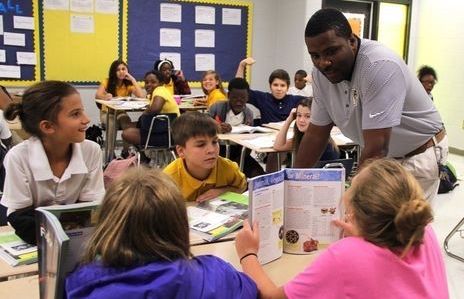 designing instruction for diversity, equity, and inclusion: We want to design activities that provide opportunities for all students to succeed, and help more students succeed, so more will experience the benefits (in school & life) of success. We want to design curriculum-and-instruction (including activities) that actually does help more students, with wider diversity, more fully actualize their whole-person potentials. We should try to “open up the options” for all students, so each will say “yes, I can do this” for a wider variety of subject-options in school and career-options in life. We want to help students choose wisely by asking “among my many options — with career choices (for “what I want to DO”) and life choices (for “who I want to BE”) — what are the goals I want to pursue (and the roads I want to travel, in school & outside, now and later) so I can build a better life?” { more – an overview and 5-step progression } { more about stories of students } designing instruction for diversity, equity, and inclusion: We want to design activities that provide opportunities for all students to succeed, and help more students succeed, so more will experience the benefits (in school & life) of success. We want to design curriculum-and-instruction (including activities) that actually does help more students, with wider diversity, more fully actualize their whole-person potentials. We should try to “open up the options” for all students, so each will say “yes, I can do this” for a wider variety of subject-options in school and career-options in life. We want to help students choose wisely by asking “among my many options — with career choices (for “what I want to DO”) and life choices (for “who I want to BE”) — what are the goals I want to pursue (and the roads I want to travel, in school & outside, now and later) so I can build a better life?” { more – an overview and 5-step progression } { more about stories of students }
learning by young students: iou – in mid-September, I'll revise these three paragraphs, beginning with my "all ages" claim for a Wide Spiral Curriculum, agreeing with the famous claim of Jerome Bruner (contradicting Jean Piaget) that "any subject can be taught effectively in some intellectually honest form to any child at any stage of development," plus his ideas – for spiral repetitions, scaffolding, social supports,... – about how to "teach effectively" for students of all ages, but especially those who are young. And I'll briefly summarize ideas from two reports made by Perplexity AI (including the pro-Bruner views of Next Generation Science Standards), and will link to a longer section in the Long-HomePage.
benefits for older and younger: Because we want to “keep options open” for all students, we should try to improve education for older students (now in high school & college) so – before they leave school – they can improve valuable cognitive-and-metacognitive skills and then use these skills for lifelong learning-and-performing after the end of their formal schooling. And we want to help younger students develop personally-useful skills (for problem solving & in other areas) and attitudes (motivations & confidence) at an early age, so they can continue improving their skills during more of their schooling – during an important stage-of-life when their neurological development is especially fast & effective – so they will be able to more fully develop their whole-person potentials.two options for timings: To grow fruit, “the best time to plant a fruit tree is 20 years ago, the second best time is now.” To grow whole-person abilities in students, the “now” can begin ASAP so each student is the youngest they ever will be. When asking if we should focus our now-responses on secondary & college (to get benefits for more students) or on elementary & middle school (so these students will get benefits for a longer time, during a crucial developmental period of their lives)? Each option has reasons (logical & ethical) to prefer it, with differing payoffs and time scales, so “do both” is the best response.
|
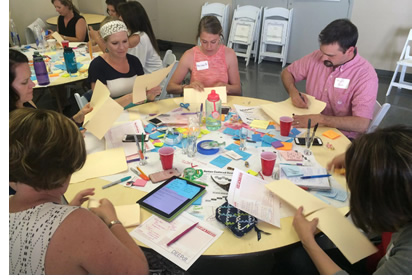 This is the Home Page for a website of Craig Rusbult, an enthusiastic educator (with a PhD in C & I ) who wants to share ideas with co-enthusiasts.* I'm optimistically excited when thinking about activities and strategies that we — using your ideas (for your schools) and my ideas, cooperatively working together — can develop and use, to help students improve their problem-solving skills in all areas of life, by helping them get more problem-solving experiences and learn more from their experiences. { two ways to quickly understand the main ideas }
This is the Home Page for a website of Craig Rusbult, an enthusiastic educator (with a PhD in C & I ) who wants to share ideas with co-enthusiasts.* I'm optimistically excited when thinking about activities and strategies that we — using your ideas (for your schools) and my ideas, cooperatively working together — can develop and use, to help students improve their problem-solving skills in all areas of life, by helping them get more problem-solving experiences and learn more from their experiences. { two ways to quickly understand the main ideas }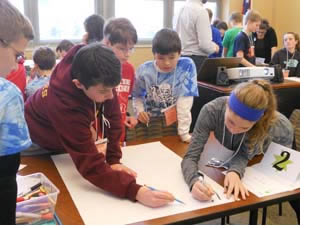 * During life on a road less traveled my PhD project at U of Wisconsin was constructing a model for “scientific method” — to describe what it IS & ISN'T, and how science uses logical Reality Checks plus other factors — and using this model to help us analyze & improve our education. Since then I've generalized this model (for Science Process) to form a model for Design Process (for Problem-Solving Process).
* During life on a road less traveled my PhD project at U of Wisconsin was constructing a model for “scientific method” — to describe what it IS & ISN'T, and how science uses logical Reality Checks plus other factors — and using this model to help us analyze & improve our education. Since then I've generalized this model (for Science Process) to form a model for Design Process (for Problem-Solving Process).
 I found this Old Model – it's “public domain” (it isn't part of the model I've constructed for Design Process) – by
I found this Old Model – it's “public domain” (it isn't part of the model I've constructed for Design Process) – by 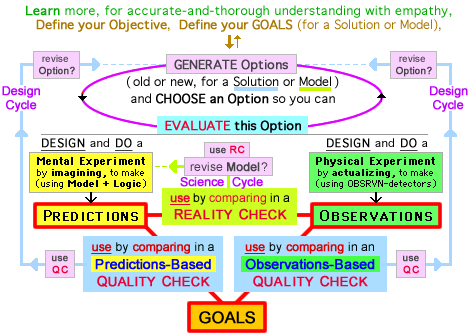 We see similarities because people use The Actions of Design Process for solving almost all problems, for almost everything we do. { also,
We see similarities because people use The Actions of Design Process for solving almost all problems, for almost everything we do. { also, 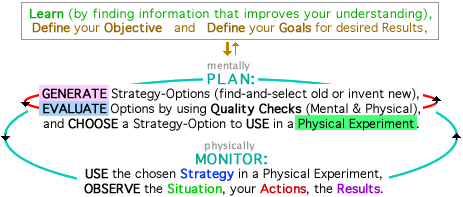 how? Compared with the simplicity of basic self-questioning, it's more difficult to teach Cycles of Self-Regulated Learning (SRL), but... it will be easier-and-better (for teachers & students) when we use Design Process, because a Cycle of SRL is very similar to a Cycle of DP, as you see in this version of
how? Compared with the simplicity of basic self-questioning, it's more difficult to teach Cycles of Self-Regulated Learning (SRL), but... it will be easier-and-better (for teachers & students) when we use Design Process, because a Cycle of SRL is very similar to a Cycle of DP, as you see in this version of 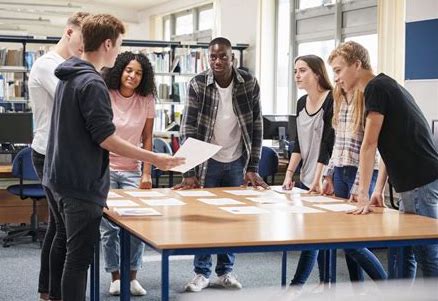 is by designing a Wide Spiral Curriculum that spans many grades in K-12, that has Wide Scope (so related learning experiences are coordinated across different areas) and uses Spiral Repetitions (so learning experiences are coordinated over time, using
is by designing a Wide Spiral Curriculum that spans many grades in K-12, that has Wide Scope (so related learning experiences are coordinated across different areas) and uses Spiral Repetitions (so learning experiences are coordinated over time, using 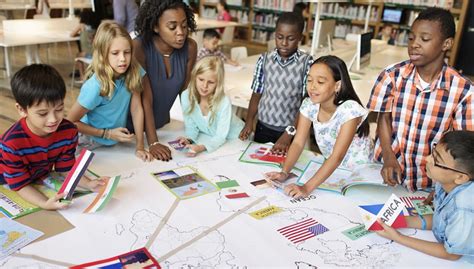 INSTRUCTION — skillfully design
INSTRUCTION — skillfully design designing instruction for diversity, equity, and inclusion: We want to design activities that provide opportunities for all students to succeed, and help more students succeed, so more will experience the benefits (in school & life) of success. We want to design curriculum-and-instruction (including activities) that actually does help more students, with wider diversity, more fully actualize
designing instruction for diversity, equity, and inclusion: We want to design activities that provide opportunities for all students to succeed, and help more students succeed, so more will experience the benefits (in school & life) of success. We want to design curriculum-and-instruction (including activities) that actually does help more students, with wider diversity, more fully actualize 